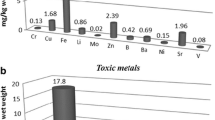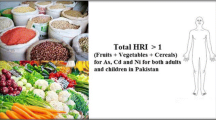Abstract
Taros are a staple in the diet of many people around the world, and they are an excellent source of minerals. Monitoring the levels of metals in food provides basic information that is useful from the perspectives of safety, regulation, and nutrition. Forty-two samples of taros were randomly obtained from supermarkets, vegetable markets, and farmer’s plots on the island of Tenerife (Canary Islands, Spain). The edible portion (pulp) was the only part considered for analysis. Flame atomic absorption spectrometry (FAAS) was used to determine the contents of Na, K, Ca, Mg, Cu, Fe, Mn, and Zn. The levels of Cr, Ni, Cd, and Pb were determined using graphite furnace atomic absorption spectrometry (GFAAS). Mean concentrations (mg/kg) were 565.6 Na, 2947 K, 231.4 Ca, 364.5 Mg, 1.224 Cu, 3.818 Fe, 1.408 Mn, 2.242 Zn, 0.044 Cr, 0.021 Ni, 0.003 Cd, and 0.006 Pb. The mean concentrations of Cd and Pb were well below the accepted European Commission limits (0.1 mg/kg weight for both metals, respectively). Daily consumption of taro (10.41 g taro/person/day) contributes to the dietary intake of essential metals and trace elements, mainly Mg (1.265 % in adult women and 1.084 % in adult men) and Cu (1.182 % for adult men and women). The average daily intakes of Cd (0.031 μg/day) and Pb (0.062 μg/day) from taro were below the legislated respective tolerable weekly intakes (TWIs). Thus, the samples analyzed were considered safe to eat based on their metal concentrations and legislated allowable intakes.
Similar content being viewed by others
References
Bhandari, M. R., Takanori, K., & Kawabata, J. (2003). Nutritional evaluation of wild yam (Dioscorea spp.) tubers of Nepal. Food Chemistry, 82, 619–623.
Cheriaghi, M., Lorestani, B., Merrikhpour, H., & Rouniasi, N. (2013). Heavy metal risk assessment for potatoes grown in overused phosphate-fertilized soils. Environmental Monitoring and Assessment, 185, 1825–1831.
Choy, E. H. S., Scott, D. L., Kingsley, G. H., Thomas, A., Murphy, A. G., Staimos, N., & Panayi, G. S. (2001). Control of rheumatoid arthritis by oral tolerance. Arthritis and Rheumatism, 44, 1993–1997.
EAC. (2011). Servicio de Estadística. Canary Islands: Consejería de Agricultura, Ganadería, Pesca y Agua.
EC (Commission Regulation). (2006). N° 1881/2006 of 19 December 2006 setting maximum levels for certain contaminants in foodstuffs. Official Journal of the European Union, L364, 5–24.
EFSA (European Food Safety Authority). (2005). Opinion of the scientific panel on dietetic products, nutrition and allergies on a request from the commission related to the tolerable upper intake level of nickel. EFSA Journal, 146, 1–21.
EFSA (European Food Safety Authority). (2010). Scientific opinion on lead in food. EFSA Journal, 8, 1570.
EFSA (European Food Safety Authority). (2011). Statement on tolerable weekly intake for cadmium. EFSA Journal, 9, 1975.
Ekpetsi Bouka, C., Lawson-Evi, P., Eklu-Gadegbeku, K., Akliokokou, K., & Gbeassor, M. (2013). Heavy metals concentration in soil, water, Manihot esculenta tuber and Oreochromis niloticus around phosphates exploitation area in Togo. Research Journal of Environmental Toxicology, 7, 18–28.
Englberger, L., Schierle, J., Kraemer, K., Aalbersberg, W., Dolodolotawake, U., Humphries, J., et al. (2008). Carotenoids and mineral content of Micronesian giant swampy taro (Cyrtosperma) cultivars. Journal of Food Composition and Analysis, 21, 93–106.
Essumang, D. K., Dadoo, D. K., Obiri, S., & Yaney, J. Y. (2007). Arsenic, cadmium, and mercury in cocoyam (Xanthosoma sagititolium) and water cocoyam (Colocasia esculenta) in Tarkwa a mining community. Bulletin of Environmental Contamination and Toxicology, 79, 377–379.
FAOSTAT. (2009). Database. Food and Agriculture Organization of the United Nations. http://faostat.fao.org/site/609default.aspx. Accessed 12 May 2013.
FAOSTAT. (2011). Potato world: World Potato Production. http://www.potato2011.org/en/world/index.html. Accessed 21 Apr 2013.
Gupta, N., Khan, D. K., & Santra, S. C. (2012). Heavy metal accumulation in vegetables grown in a long-term wastewater-irrigated agricultural land of tropical India. Environmental Monitoring and Assessment, 184, 6673–6682.
IUPAC (International Union of Pure and Applied Chemistry). (1995). Nomenclature in evaluation of analytical methods including detection and quantification capabilities. Pure and Applied Chemistry, 67, 1699–1723.
Lebot, V., Champagne, A., Malapa, R., & Shiley, D. (2009). NIR determination of major constituents in tropical root and tuber crop flours. Journal of Agricultural and Food Chemistry, 57, 10539–10547.
Leterme, P., Buldgen, A., Estrada, F., & Londoño, A. M. (2006). Mineral content of tropical fruits and unconventional foods of the Andes and the rain forest of Colombia. Food Chemistry, 95, 644–652.
Lewu, M. N., Adebola, P. O., & Afolayan, A. J. (2010). Effect of cooking on the mineral contents and anti-nutritional factors in seven accessions of Colocasia esculenta (L.) Schott growing in South Africa. Journal of Food Composition and Analysis, 23, 389–393.
Luis, G., Rubio, C., González-Weller, D., Gutiérrez, A., Hardisson, A., & Revert, C. (2011). Comparative study of the mineral composition of several varieties of potatoes (Solanum tuberosum L.) from different countries cultivated in Canary Islands (Spain). International Journal of Food Science and Technology, 46, 774–780.
Luis, G., Rubio, C., Gutiérrez, A. J., González-Weller, D., Revert, C., & Hardisson, A. (2014). Evaluation of metals in several varieties of sweet potatoes (Ipomoea batatas L.): comparative study. Environmental Monitoring and Assessment, 186, 433–440.
Nabulo, G., Oryem-Origa, H., & Diamond, M. (2006). Assessment of lead, cadmium, and zinc contamination of roadside soils, surface films, and vegetables in Kampala city, Uganda. Environmental Research, 101, 42–52.
Onianwa, P. C., Lawal, J. A., Ogunkeye, A. A., & Orejimi, B. M. (2000). Cadmium and nickel composition of Nigerian foods. Journal of Food Composition and Analysis, 13, 961–969.
Onwueme, I. (1999). Taro cultivation in Asia and the Pacific. Bangkok: Food and Agriculture Organization of the United Nations Regional Office for Asia and the Pacific.
Orech, F. O., Christensen, D. L., Larsen, T., Friis, H., Aagaard-Hansen, J., & Estambale, B. A. (2007). Mineral content of traditional leafy vegetables from western Kenya. International Journal of Food Sciences and Nutrition, 58, 595–602.
Pan, G. (2002). Confidence intervals for comparing two scale parameters based on Levene’s statistics. Journal of Nonparametric Statistics, 4, 459–476.
Perdomo, A. C. (2000). Los manantiales de ñames (Colocasia esculenta) de Ánaga (Tenerife). Cuadernos de Etnografía Canaria, 7, 36–41.
Turconi, G., Minoia, C., Ronchi, A., & Roggi, C. (2009). Dietary exposure estimates of twenty-one trace elements from a total diet study carried out in Pavia, Northern Italy. The British Journal of Nutrition, 101, 1200–1208.
Udensi, E. A., Oselebe, H. O., Iweala, O. O. (2008). The investigation of chemical composition and functional properties of water yam: effect of varietal differences. Pakistan Journal Nutrititon, 7, 342–344.
Xu, P., Huang, S., Zhue, R., Han, X., & Zhou, H. (2002). Phenotypic polymorphism of CYP2A6 activity in a Chinese population. European Journal of Clinical Pharmacology, 58, 333–337.
Yan, S., Ling, Q. C., & Bao, Z. Y. (2007). Metals contamination in soils and vegetables in metal smelter contaminated sites in Huangshi, China. Bulletin of Environmental Contamination and Toxicology, 79, 361–366.
Zhuang, P., McBride, M. B., Xia, H., Li, N., & Li, Z. (2009). Health risk from heavy metals via consumption of food crops in the vicinity of Dabaoshan mine, South China. The Science of the Total Environment, 407, 1551–1561.
Author information
Authors and Affiliations
Corresponding author
Rights and permissions
About this article
Cite this article
Luis-González, G., Rubio, C., Gutiérrez, Á. et al. Essential and toxic metals in taros (Colocasia esculenta) cultivated in the Canary Islands (Spain): evaluation of content and estimate of daily intake. Environ Monit Assess 187, 4138 (2015). https://doi.org/10.1007/s10661-014-4138-2
Received:
Accepted:
Published:
DOI: https://doi.org/10.1007/s10661-014-4138-2




